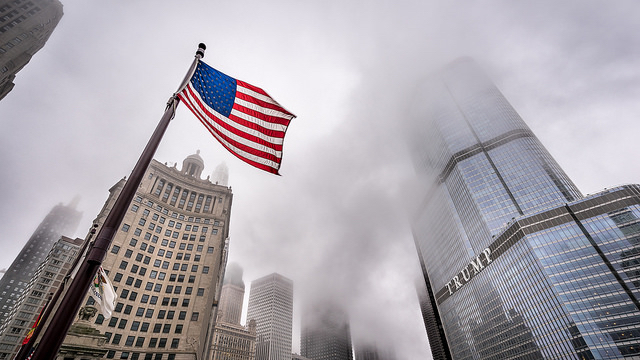The United States is at a crossroads, one that few on the left thought would arrive at as recently as last week. The election of Donald Trump to the presidency is the harbinger of the most severe crisis to face the democratic institutions of this country since the late 1850s.
In the course of Trump’s campaign he denigrated women, the handicapped, people of color, the US Constitution, and practically every other basis of what passes for civilization here. Indeed, it was his buffoonery, no less than the absurdity of his political positions, which convinced many on the left that he could not be elected. About this they were wrong. They were also wrong about the concern of a large part of the electorate with anything reasonably approximating a factually valid account of the real. The motto of the Trump presidency, as of his campaign, might as well be, “So much the worse for the facts.”
Two issues present themselves at this point: Why it happened, and what dangers are now on the horizon. What follows are some back-of-the-envelope considerations on both. They should not be mistaken for the sort of deep analysis that must follow in the weeks and months ahead. But, given the fact that the picture of American politics and the electorate is so different than it seemed a month ago, and so different than it seemed to even the most prescient of the pollsters, it is worth considering just exactly what it is that we have to fear at this moment.
The election of Donald Trump, surprising and alarming as it was, was not evidence of some sort of tectonic shift in US politics. The bases of his election were clear to see. The Republican party had spent decades ginning up people in the middle and lower reaches of the income distribution, padding its own electoral totals by getting them to vote against their own economic interest. They did this through more or less overt appeals to xenophobia of various stripes, all the while relying on the a vision of the American dream long since absent from the prospects of actual Americans as the positive dimension of their politics. John Steinbeck once wrote of the problems of socialist organizing in the 1930s, “I guess the trouble was that we didn’t have any self-admitted proletarians. Everyone was a temporarily embarrassed capitalist.” The combination of xenophobia and economic delusion was a potent mix, one in which the virulence of the former grew with the diminution of the latter.
The goal of the program was to get wide swaths of the population to accept the consequences of neoliberalism even as it led to their own impoverishment. Donald Trump’s campaign, which mostly distinguished itself by its (and his) willingness to make openly racist and misogynist statements rather than simply delivering them via dog whistle with and accompanying nod and wink, was merely the fullest expression of the fact that the Republican Party hasn’t had a positive political program since the days of Ronald Reagan.

The Democratic Party did its bit to abet this project. One should be dubious of the claims (made with ever greater fervency since the end of the election) that Bernie Sanders could have actually defeated Trump. But his brand of moderate democratic socialism did present an alternative that clearly got some traction with important segments of the electorate, particularly younger ones. In any case, the Democratic establishment had already anointed Hillary Rodham Clinton long before the primaries began. She was, for them, the ideal candidate: experienced, female, and committed to defending the sort of neoliberalism with a human face beloved of the less soulless wing of US financial elites.
The failure of Clinton’s campaign has set of some very agitated debates within the leftward tendency of American politics. One now frequently hears the assertion that Clinton’s candidacy was doomed because she was a “flawed” candidate. Others have rightly pointed out that, generally speaking, this is code for “she was a women,” a perfectly idiotic explanation of the demise of her electoral prospects. Clearly, she was a much-maligned figure on the political right. So was Barack Obama, and for analogous reasons, which had everything to do with identity and little to do with actual political views. But there is no reason to think that there was any intrinsic reason that Clinton could not have overcome this in the way that Obama did, especially given the open buffoonery of her opponent.
Clinton’s campaign was certainly flawed. It made little or no attempt to address the concerns of people left behind of global neoliberalism. And she did little to attract the more progressive wing of the party. The flaw in Clinton’s campaign was not so much about her as a candidate. The flaw was that she was the representative of a Democratic establishment that represents not an alternative the Republicans but an alternative segment of capital.
Other contingent factors were really out of her control. How could she have coped otherwise with the fact that the US news media would completely fail in their responsibility to apply the most basic critical faculty to Trump’s outlandish claims. Instead they allowed the creation of an absurd equivalence between things like Benghazi (investigated by a hostile congressional committee for thirteen months and at a cost of $13 million with nothing of consequence being uncovered) and the demonstrable falsehoods that emerged from the Trump campaign every time the candidate opened his mouth. The affair of the Wiener emails was really only the institutional icing on the cake.
Even with all of this, Trump was only elected by about 25% of eligible voters. For all of the crowing of his supporters, his tally was in fact lower than that of either McCain or Romney. Even amongst that group, it was probably less than half that were actually avid supporters of the candidate himself, as opposed to Republicans too jaundiced or too hateful to accede to the election of any Democrat. On the other hand it’s probably worth noting that Adolf Hitler never got more than 38% of the vote in any non-coercive election.

As I’ve said many times before, we should avoid simplistic comparisons to Hitler. To my mind, there are other, more substantive parallels to draw. One might be to Heinrich Brüning, the Catholic politician whose disastrous term as Chancellor of Germany from 1930 to 1932 was the precursor to Hitler’s rise. There are clearly a lot of differences, but Brüning was an autocrat by instinct and his ideologically driven economic ideas were instrumental in sparking the catastrophic deflation created a path to power for the Nazis. Trump’s economic ideas, to the extent that anyone knows what they are, seem likely to have the same aggregate effect.
Herein lies the real danger. Trump is likely to move the United States in the direction of Putin’s kleptocracy. With a supine Republican majority in both houses of Congress he will have little in terms of resistance to his policy of destroying the institutions and structures of civil society in this country. But more dangerous still are the promises that he has made to lower and middle class whites that he will regenerate blue collar employment (and thereby some sort of true middle class in the United States). This he simply cannot do. Trump can incentivize reshoring of factories, but he cannot roll back the development of automation. The stable, reasonably well-paid jobs that built postwar middle class are mostly gone for good. No amount of “Make America Great Again” caps will change this.
Trump has brought the toxic Republican brew to the boil. In doing so he has created expectations that he cannot fulfill among angry people, many of whom are heavily armed. The danger is not so much Trump, although there is much damage the he can do. The danger is what sort of movement arises out of the ruins generated by his false promises. The Republican Party, and the political classes are busily sewing the wind. It remains to be seen what will remain once we all reap the whirlwind.
Photographs courtesy of Giuseppe Milo, Elton Lin, and Azi Paybarah. Published under a Creative Commons license.





